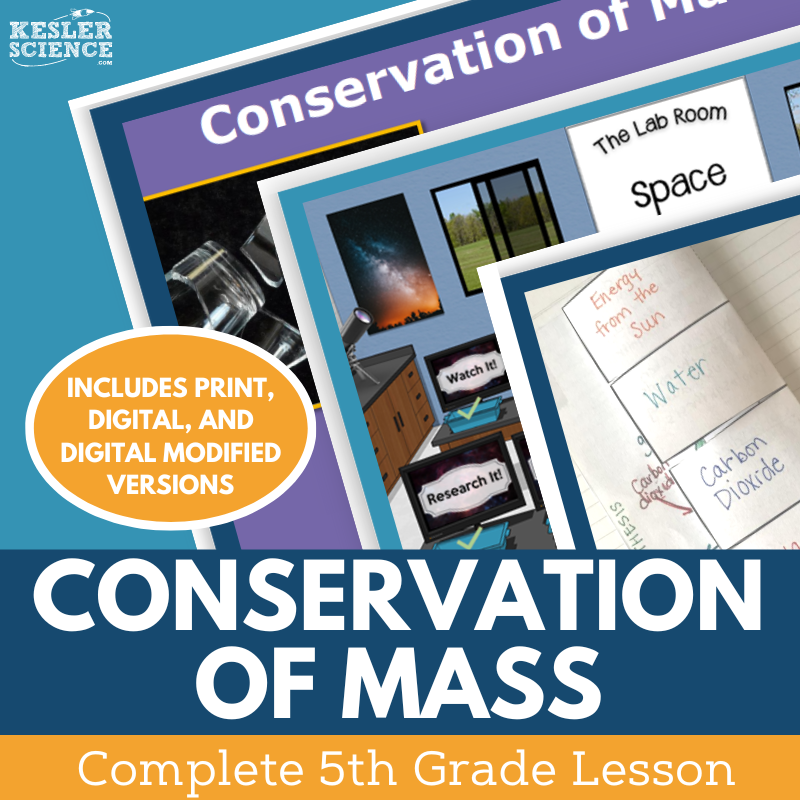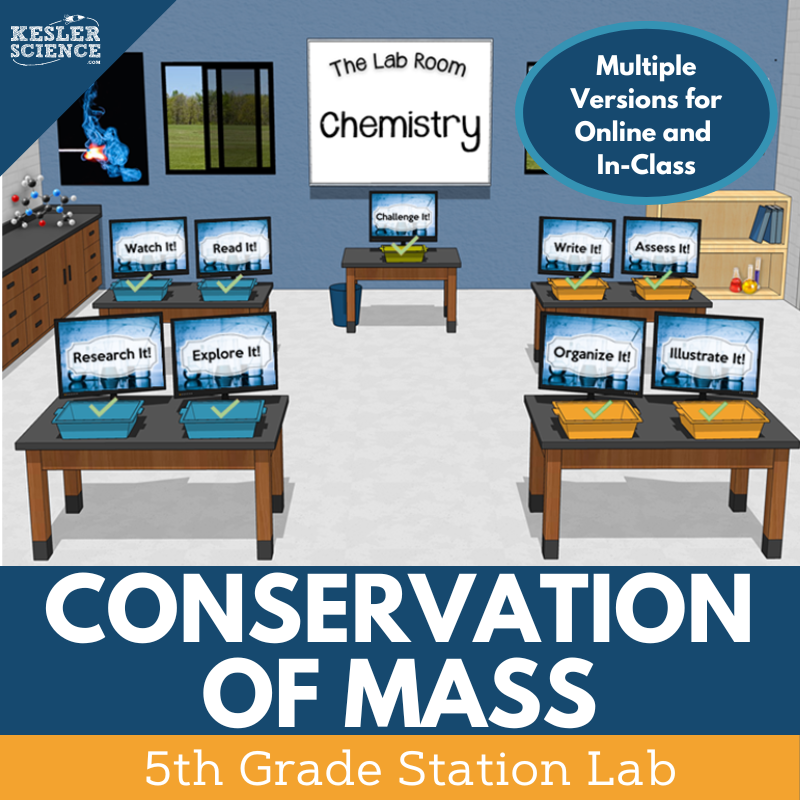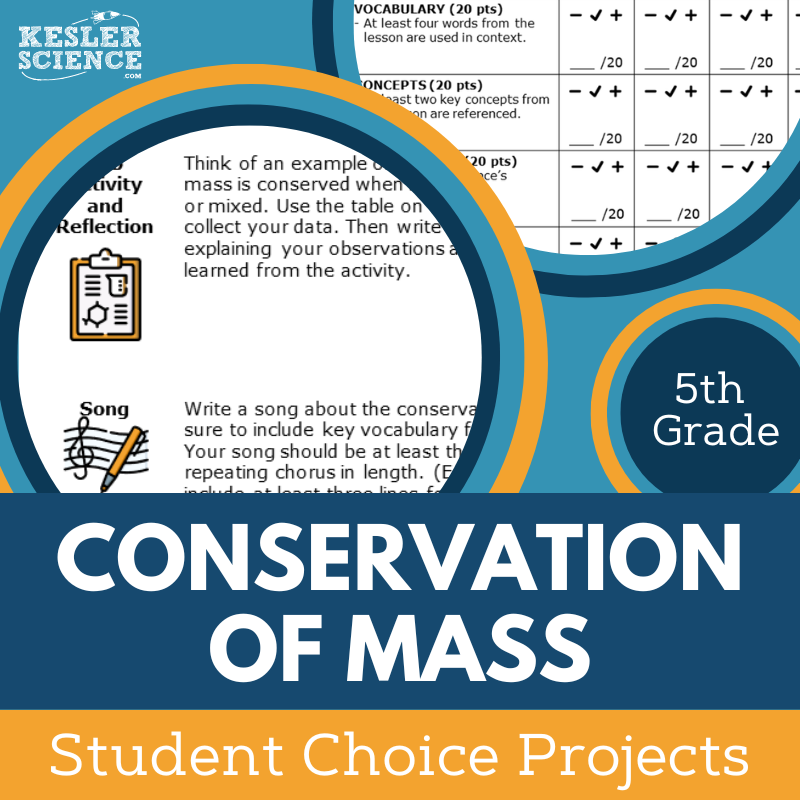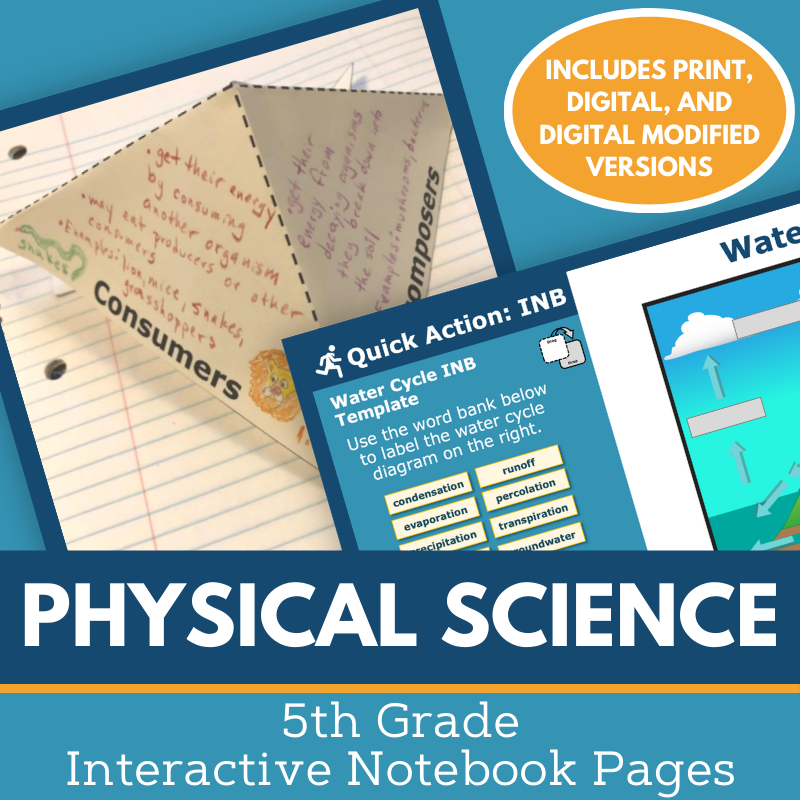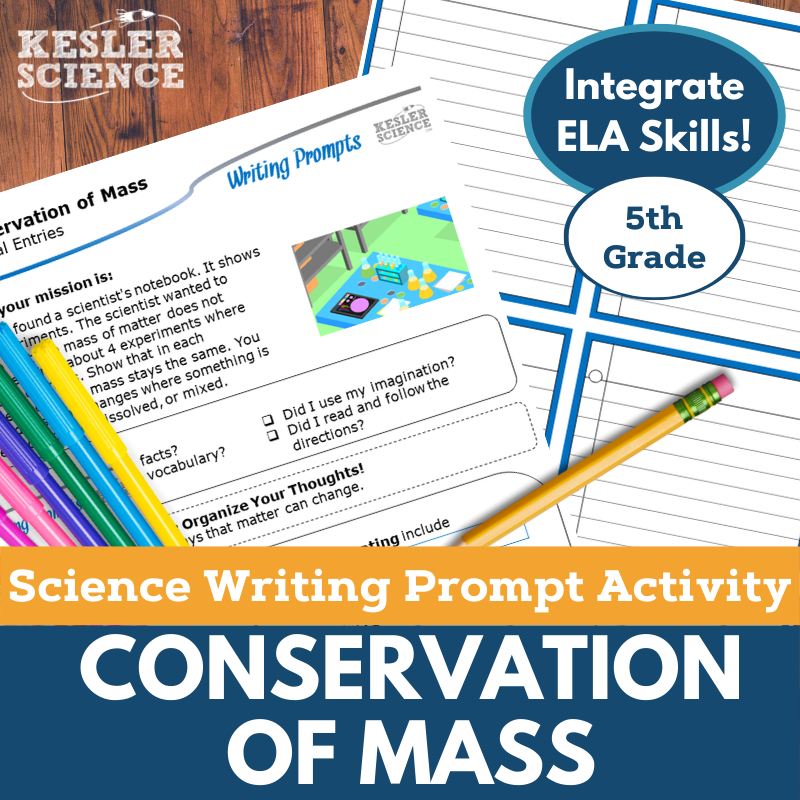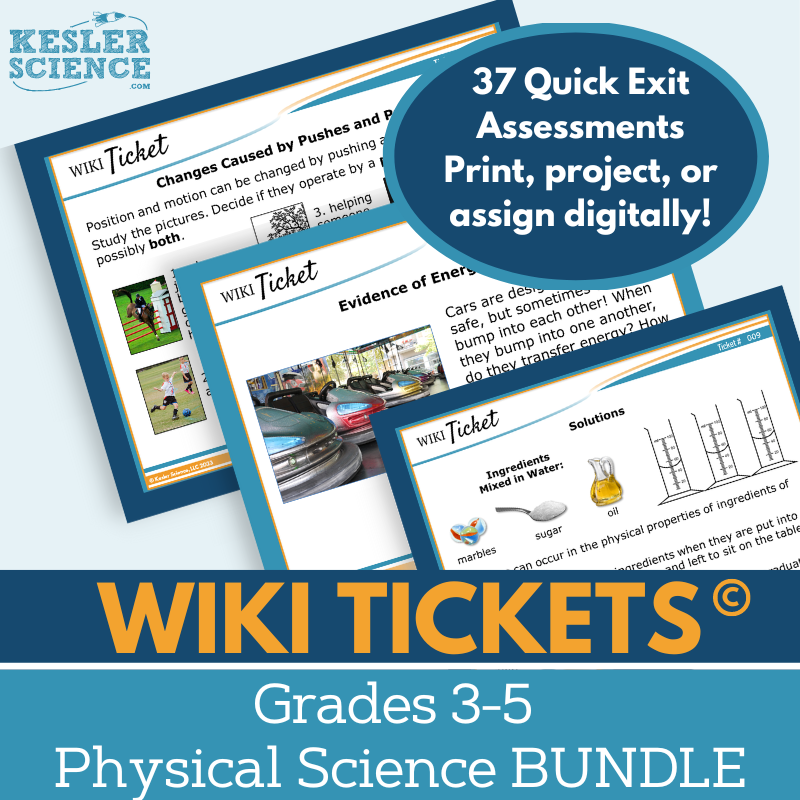Conservation of Mass Activities for 5th Grade Science
The Kesler Science Conservation of Mass resources provides a student-led curriculum for 5th grade that includes differentiated activities, hands-on station labs, editable PowerPoints, and interactive notebooks. The resources below will give students a comprehensive understanding of conservation of mass. All of the following materials are also included in the Kesler Science Membership.
This engaging elementary chemistry unit on conservation of mass introduces students to physical and chemical changes while helping them understand that mass remains consistent throughout these processes. The lesson follows the 5E Model—Engage, Explore, Explain, Elaborate, and Evaluate—and includes low-prep, editable materials like presentations, worksheets, student-choice projects, and assessments. It’s designed to support differentiated, student-led learning and keep students actively involved in discovering how matter changes without losing mass.
The exploration phase features a hands-on, differentiated station lab with nine modular activities, including reading passages, video analysis, experiments, and extension challenges. Students absorb content through multimodal input stations and demonstrate their understanding through writing, sketching, sorting, and answering assessment questions. All resources are available in English and Spanish to support a diverse range of learners.
For explanation and elaboration, the unit provides interactive notebook templates, editable PowerPoints, and student-choice projects to deepen understanding. The evaluation phase includes STAAR 2.0-aligned assessments in multiple formats. This resource is flexible for in-class or virtual learning, making it a versatile addition to any 5th-grade science curriculum.
This engaging elementary chemistry unit on conservation of mass introduces students to physical and chemical changes while helping them understand that mass remains consistent throughout these processes. The lesson follows the 5E Model—Engage, Explore, Explain, Elaborate, and Evaluate—and includes low-prep, editable materials like presentations, worksheets, student-choice projects, and assessments. It’s designed to support differentiated, student-led learning and keep students actively involved in discovering how matter changes without losing mass.
The exploration phase features a hands-on, differentiated station lab with nine modular activities, including reading passages, video analysis, experiments, and extension challenges. Students absorb content through multimodal input stations and demonstrate their understanding through writing, sketching, sorting, and answering assessment questions. All resources are available in English and Spanish to support a diverse range of learners.
For explanation and elaboration, the unit provides interactive notebook templates, editable PowerPoints, and student-choice projects to deepen understanding. The evaluation phase includes STAAR 2.0-aligned assessments in multiple formats. This resource is flexible for in-class or virtual learning, making it a versatile addition to any 5th-grade science curriculum.
Engage your classroom with this student-led station lab on conservation of mass, designed to support fifth-grade students through hands-on and interactive learning. Aligned with physical science standards, students explore how matter behaves during physical and chemical changes by measuring and graphing evidence that mass remains constant, regardless of the type of change. This ready-to-use resource includes both in-class and virtual options to suit any learning environment.
The lab features nine modular stations, including eight differentiated learning activities and a ninth challenge station for early finishers. Students explore the concept through videos, readings, research, hands-on demonstrations, and digital interactions. They then demonstrate understanding by organizing information, drawing models, answering prompts, and completing assessments. English and Spanish reading passages support a variety of learners, and the flexible format works with PowerPoint and Google Slides.
Each station offers a unique opportunity for input or output. Students observe demonstrations, analyze text and media, and research scientific concepts before creating visuals, writing responses, manipulating models, and taking assessments. With clear instructions, editable materials, and minimal prep, this station lab encourages student ownership of learning while reinforcing the law of conservation of mass.
Engage your classroom with this student-led station lab on conservation of mass, designed to support fifth-grade students through hands-on and interactive learning. Aligned with physical science standards, students explore how matter behaves during physical and chemical changes by measuring and graphing evidence that mass remains constant, regardless of the type of change. This ready-to-use resource includes both in-class and virtual options to suit any learning environment.
The lab features nine modular stations, including eight differentiated learning activities and a ninth challenge station for early finishers. Students explore the concept through videos, readings, research, hands-on demonstrations, and digital interactions. They then demonstrate understanding by organizing information, drawing models, answering prompts, and completing assessments. English and Spanish reading passages support a variety of learners, and the flexible format works with PowerPoint and Google Slides.
Each station offers a unique opportunity for input or output. Students observe demonstrations, analyze text and media, and research scientific concepts before creating visuals, writing responses, manipulating models, and taking assessments. With clear instructions, editable materials, and minimal prep, this station lab encourages student ownership of learning while reinforcing the law of conservation of mass.
The Kesler Science Conservation of Mass Student Choice Projects empower 5th graders to select a project that aligns with their individual learning styles. Students can choose from nine options or design their own, with a grading rubric adaptable for teachers, peers, or self-assessment. This dynamic lesson promotes creativity, allowing students to showcase their understanding through various mediums, from traditional materials to digital presentations.
With nine project choices and a flexible rubric, the lesson fosters personalized learning. Teachers are supported with a directions page and editable rubric, assessing vocabulary, concepts, presentation, and accuracy. The project includes both differentiated options and extensions for students needing additional support or challenge.
The resources require only basic classroom supplies, such as paper and markers, while some projects may benefit from crafting materials. The adaptable nature of the lesson allows for both digital and hands-on approaches to exploring the concept of mass conservation.
The Kesler Science Conservation of Mass Student Choice Projects empower 5th graders to select a project that aligns with their individual learning styles. Students can choose from nine options or design their own, with a grading rubric adaptable for teachers, peers, or self-assessment. This dynamic lesson promotes creativity, allowing students to showcase their understanding through various mediums, from traditional materials to digital presentations.
With nine project choices and a flexible rubric, the lesson fosters personalized learning. Teachers are supported with a directions page and editable rubric, assessing vocabulary, concepts, presentation, and accuracy. The project includes both differentiated options and extensions for students needing additional support or challenge.
The resources require only basic classroom supplies, such as paper and markers, while some projects may benefit from crafting materials. The adaptable nature of the lesson allows for both digital and hands-on approaches to exploring the concept of mass conservation.
The Kesler Science Physical Science Interactive Notebook bundle engages elementary students in 13 essential physical science topics with both print and digital formats. This versatile resource supports traditional classrooms, 1:1 environments, and distance learning, ensuring all students can actively participate.
The digital version includes an interactive PowerPoint that can be uploaded to Google Slides and various LMS platforms, with reflection pages, note-taking spaces, teacher answer keys, and a modified version for accommodations. The paper version provides blank and pre-filled templates, along with color photos for guidance.
Topics range from properties of matter and energy use to gravitational force and circuits. Whether used for interactive learning, differentiation, or student reflection, this notebook bundle makes science more engaging and accessible.
The Kesler Science Physical Science Interactive Notebook bundle engages elementary students in 13 essential physical science topics with both print and digital formats. This versatile resource supports traditional classrooms, 1:1 environments, and distance learning, ensuring all students can actively participate.
The digital version includes an interactive PowerPoint that can be uploaded to Google Slides and various LMS platforms, with reflection pages, note-taking spaces, teacher answer keys, and a modified version for accommodations. The paper version provides blank and pre-filled templates, along with color photos for guidance.
Topics range from properties of matter and energy use to gravitational force and circuits. Whether used for interactive learning, differentiation, or student reflection, this notebook bundle makes science more engaging and accessible.
The Conservation of Mass Science Writing Activity engages 5th grade students in a journal entry exercise to deepen their understanding of physical science concepts. Aligned with NGSS 5-PS1-2, this activity prompts students to explore how the total weight of matter is conserved during physical and chemical changes. Using a creative, student-centered format, this writing task strengthens science reasoning while supporting both in-person and virtual learning environments.
This low-prep resource includes teacher directions with rubrics and project ideas, as well as full- and half-sheet student handouts featuring prompts, self-checks, and pre-writing strategies. A digital version is available in PowerPoint and Google Slides formats for flexible classroom use. Students can complete the activity individually or as part of a journal anthology or class display.
Ideal for elaboration, student choice projects, or cross-curricular learning, this writing prompt also works well as a pre-test, extra credit, make-up work, or a TELPAS sample. Designed for students who already have background knowledge or access to research materials, the prompt offers differentiated options to enrich learning and boost science literacy.
The Conservation of Mass Science Writing Activity engages 5th grade students in a journal entry exercise to deepen their understanding of physical science concepts. Aligned with NGSS 5-PS1-2, this activity prompts students to explore how the total weight of matter is conserved during physical and chemical changes. Using a creative, student-centered format, this writing task strengthens science reasoning while supporting both in-person and virtual learning environments.
This low-prep resource includes teacher directions with rubrics and project ideas, as well as full- and half-sheet student handouts featuring prompts, self-checks, and pre-writing strategies. A digital version is available in PowerPoint and Google Slides formats for flexible classroom use. Students can complete the activity individually or as part of a journal anthology or class display.
Ideal for elaboration, student choice projects, or cross-curricular learning, this writing prompt also works well as a pre-test, extra credit, make-up work, or a TELPAS sample. Designed for students who already have background knowledge or access to research materials, the prompt offers differentiated options to enrich learning and boost science literacy.
The Kesler Science Physical Science WIKI Tickets provide 3rd–5th grade teachers with engaging, low-prep formative assessments. These colorful exit tickets help quickly gauge student understanding in chemistry, energy, and force and motion topics, aligning with NGSS and TEKS standards. Each of the 37 topics includes five formats: a full-screen display, three printable handout sizes, and a digital interactive version in PowerPoint or Google Slides.
WIKI Tickets are versatile for any learning environment. Teachers can project them for class discussions, print them for written responses, or assign them digitally for remote learning. The included table of contents file ensures seamless alignment with science standards, making assessments easy and effective.
With WIKI standing for “What I Know Is,” these tickets work as bellringers, exit slips, or quick checks for understanding. Whether in class or online, this resource offers a simple yet powerful way to track student progress in physical science concepts.
The Kesler Science Physical Science WIKI Tickets provide 3rd–5th grade teachers with engaging, low-prep formative assessments. These colorful exit tickets help quickly gauge student understanding in chemistry, energy, and force and motion topics, aligning with NGSS and TEKS standards. Each of the 37 topics includes five formats: a full-screen display, three printable handout sizes, and a digital interactive version in PowerPoint or Google Slides.
WIKI Tickets are versatile for any learning environment. Teachers can project them for class discussions, print them for written responses, or assign them digitally for remote learning. The included table of contents file ensures seamless alignment with science standards, making assessments easy and effective.
With WIKI standing for “What I Know Is,” these tickets work as bellringers, exit slips, or quick checks for understanding. Whether in class or online, this resource offers a simple yet powerful way to track student progress in physical science concepts.
Year-Round Resources
These year-round activities will increase your students' understanding of many middle school science topics. All of these activities are also included in the Kesler Science Membership.
Visual Data & Graphing
You're not alone if your students struggle with understanding graphs, charts, and tables. It's a skill that takes an enormous amount of practice. This resource will help students build a strong foundation in analyzing data and creating their own data visualizations.
Bell Ringers and Warm-Ups
These middle school science bell ringers are an excellent way to engage your students as soon as they walk into your classroom. This comprehensive FULL YEAR resource includes everything you need to start off each science class with an interesting warm-up activity.
Review Board Games
Each game board has been carefully designed to keep students engaged. There are 10 different action spaces on each board and dozens of question cards. All of the actions are related to science concepts and keep the students motivated throughout the game.
Each game is ready to play. Simply print out the board and the cards and let the students enjoy reviewing nine different units.
Essential Questions
Below are the essential questions associated with the lessons and activities included in this unit. This topic is only one of more than 100 middle school science topics included in the Kesler Science Membership.
-
In what ways can matter change?
-
During physical and chemical changes, does the mass of the substance(s) change?
Kesler Science Membership
Imagine never having to search for another middle school science lesson again. The membership gives you access to ALL of the Kesler Science products in one place (Yes, including everything above).
Say goodbye to long hours of lesson prep.

